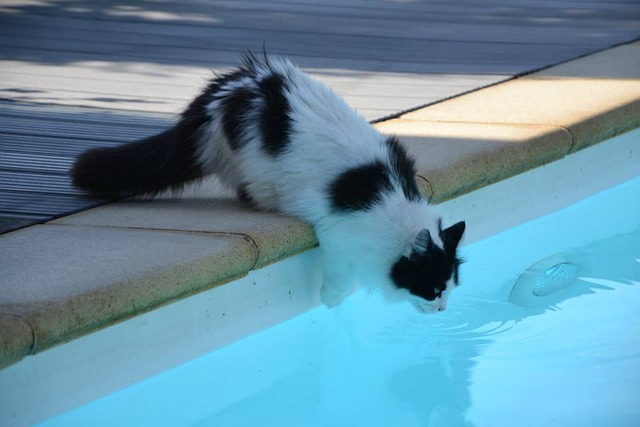Can Cats Swim?

Are you one of those curious souls who lie awake at night, pondering mysteries like whether cats possess the aquatic prowess to swim?
I feel ya.
We're gonna dive deep into this feline enigma together 😺.
Ready to unravel the truth?
Let's jump in.
Can Cats Swim Naturally?
While some cat breeds, like the Turkish Van and Maine Coon, have a natural talent for swimming, not all cats are equally skilled. Cats rely on strength, dexterity, and mental fortitude to swim successfully, but their fur doesn't repel water well, making swimming uncomfortable for them.
Falsehoods aside, cats have the innate ability to swim, just like their wild relatives. But don't be fooled, not all cats are equal when it comes to their swimming skills. Some breeds, like the Turkish Van and Maine Coon breeds, have a natural knack for swimming that'll leave you in awe.
They're basically the Michael Phelps of the cat world!
You might be surprised to see these water-loving felines eagerly diving into the deep end without any hesitation.
However, other domestic cat breeds, which originated in dry environments, may not have honed their swimming abilities as much. Nevertheless, they still have that inner instinct that kicks in when they find themselves surrounded by H2O.
To excel in their aquatic endeavors, cats rely on physical strength, dexterity, and mental fortitude.
Just like humans who take to the water, they need a combination of strength and endurance to navigate through the waves successfully.
Though, let's not forget about their furry coats.
Unfortunately, their fur doesn't repel water effectively, meaning they often end up with soggy fur that hampers their mobility.
Imagine those poor kitties stepping out of a pool with dripping wet hair – definitely not the most comfortable situation for them!
But fear not, because physically fit and mentally prepared cats can indeed swim independently. However, if your cat has certain conditions like arthritis or simply lacks confidence in the water, equipping them with a life jacket could provide that extra support and peace of mind during their aquatic adventures.
All in all, while cats may not be the biggest enthusiasts of splashing around, they still possess an impressive swimming potential. Be sure to keep an eye on your furry friend's abilities and comfort level in the water, and never force them into a swim if they're not up for it.
Their well-being always comes first.
And if you're still wondering about the incredible instincts of these water-loving felines, I assure you, there's more to discover.
To truly understand the remarkable abilities of our feline friends, I invite you to delve into my article: Can Cats Find Their Way Home if Lost.
Cats Who Love Water
If you have a water-loving feline, here are 12 factors to consider:
- Abyssinian cats are known for their affinity towards water.
- Maine Coons, Bengals, and Manx cats also enjoy water activities.
- Swimming preferences vary by cat, depending on factors like breed.
- Cats may paddle or splash in water, but they don't swim fast.
- Most cats feel more secure on dry land than in water.
- Some cats, like Abyssinians and Bengals, have a stronger attraction to water.
- Falling water from faucets, sprinklers, and fountains can be enticing.
- Big cats, such as tigers and lions, rely on water for temperature regulation.
- Always supervise cats when they swim.
- Safety measures like pool alarms and fences are crucial.
- Early exposure to swimming increases the chances of enjoyment.
- Swimming provides joint-friendly exercise for cats. 😺
So, you might be wondering how to turn your non-water loving cat into a graceful swimmer.

Well, let me show you!
Introducing Cats to Water
Start slow and let your cat explore at their own pace
If you want to introduce your cat to the magical world of water, take it easy and allow them to discover it on their terms. Begin by using a shallow basin or sink filled with a tad bit of lukewarm water.
This way, your furry friend can dip their cute little paws in and get familiar with the idea.
Don't ever force your feline companion into unknown depths; it would be equally dreadful for both of us.
Instead, entice them with treats, praise, and enticing toys that make water appear as a delightful adventure.
Let's have some fun playtime together.
Gradually introduce more water and reinforce positive experiences
Once your four-legged pal warms up to the idea of water, we can gradually increase the water level and see if they still possess that adventurous spirit.
Remember, my dear friend, you need to use positive reinforcement throughout this process!
Shower your beloved kitty with heaps of praise and mouthwatering treats whenever they make progress. Oh, don't forget those delicate ears after any water contact; I wouldn't want any pesky infections lurking beneath those charming tufts, would you?

Also, ensure to rinse and dry their fur appropriately, so there are no lingering chemicals or bacteria from their swim.
We must keep them clean!
Acclimatize early, especially if you live near water
Living by the mesmerizing waterside can indeed be a dream come true, but it may pose certain challenges when you share it with a furry companion.
So, if you have an adorable young fluff ball in your life, make sure to introduce them to swimming slowly and gently. Always watch over their aquatic adventures and ensure they are relaxed before dipping their toes into the water.
Our ultimate goal here is to provide a calm and soothing experience for our beloved friends. Have patience, invest time, and who knows, your kitty may eventually come to embrace the water and transform into an agile swimmer.
Now, you might be wondering how to overcome these challenges and successfully train your cat to enjoy water.
That's where gradual desensitization comes into play.
By understanding the reasons behind their aversion and using positive reinforcement techniques, you can slowly transform your feline friend into a confident swimmer.
But how exactly does this process work?
Let me reveal the step-by-step guide for training your cat to embrace the aquatic world...
Training Cats: Overcoming Water Aversion
When it comes to training cats who don't like water, take it slow and steady.
Cats can be picky creatures, so it's not uncommon for them to develop a dislike for water.
There are a few reasons why cats may not be fans of water - maybe they had a bad experience or just don't like the smell of tap water.
Now, let me give you some advice on how to help your cat overcome their aversion:
- Don't force your cat to swim if they're not up for it. It'll only make things worse.
- Cats have sensitive noses, so using filtered water could help reduce any chemical smells they find off-putting.
- Cats prefer liquids that feel more like their fur, so try warming up the water a bit before introducing it to them.
- Keep an eye on your cat while they're playing with water to make sure they stay safe. Getting wet can leave cats feeling vulnerable and limit their movement.
- Remember, traumatic water experiences can have a lasting impact, so be patient as you work on overcoming their fear.
- Use positive reinforcement, like extra cuddles and treats, to encourage your cat during water training sessions.
- Start small by exposing their head to water and praise and reward them when they start paddling around.
- Just keep in mind that older cats or cats who've never been fond of water might need a little extra patience.
With these tips in mind, training cats to be okay with water doesn't have to feel overwhelming.
And believe me, when I say I've got a valuable resource that can help address an equally important topic regarding feline behavior.
In my extensive guide on cat behavior, I cover the intriguing question of whether cats are capable of opening doors.
If your curiosity is piqued, and you're eager to find out how you can prevent this from happening, I highly recommend checking out my article Can Cats Open Doors.
Where Should You Take Your Cat Swimming?
Safety should be your number one concern when it comes to taking your cat swimming.
To ensure a safe and controlled experience, set up an outdoor enclosure with a shallow pool specifically designed for cats.
Rivers and lakes can be risky, so opt for a home pool that has easy exits for your furry friend.
Remember, safety is key!
Investing in a pool or pond cover is a great idea to provide extra protection.
Also, ensure there are exit points near any bodies of water to keep your cat safe.
Don't forget to regularly check the pool chemicals to prevent any harm.
And most importantly, don't let your cat drink from the pool as those chemicals could be toxic.
Here's a pro tip for you:
Consider getting cat insurance. Companies like Purely Pets offer different coverage options and benefits that can help protect your cat from water-related injuries or illnesses.
If you need professional assistance with swimming rehabilitation for your cat, reach out to a veterinary clinic like Everhart Veterinary Medicine.
When it comes to your cat swimming, their safety should always be your top priority.
Ending notes
Key Takeaways:
- Cats are capable of swimming, but not all cats are good swimmers.
- Cats have a natural instinct for swimming, but some breeds are more fond of water.
- Cats with conditions like arthritis may need a life jacket for swimming.
- Introduce cats to swimming at an early age for a higher likelihood of enjoyment.
- Coax cats into water with treats, praise, and toys, rather than forcing them.
- Dry a cat's ears after water contact to prevent infections.
- Cats may have a dislike of water due to negative experiences or aversion.
- Supervision is necessary to ensure a cat's safety in water.
- Prioritize water safety when deciding where to take your cat swimming.
- Consider getting cat insurance to protect against water-related injuries or illnesses.
And that wraps up today's article.
If you wish to read more of my useful articles, I recommend you check out some of these: Can Cats See in the Dark, Should You Lock Your Cat in a Bathroom at Night, Pregnant Cat Keeps Meowing, Why Wont My Cat Shut Up, and Can I Keep My Cat in the Garage at Night
Talk soon,
-Sarah Davis